
Made in Japan! & World's first! Captivating
I will teach you "Gamenics Theory"
I will teach you "Gamenics Theory"

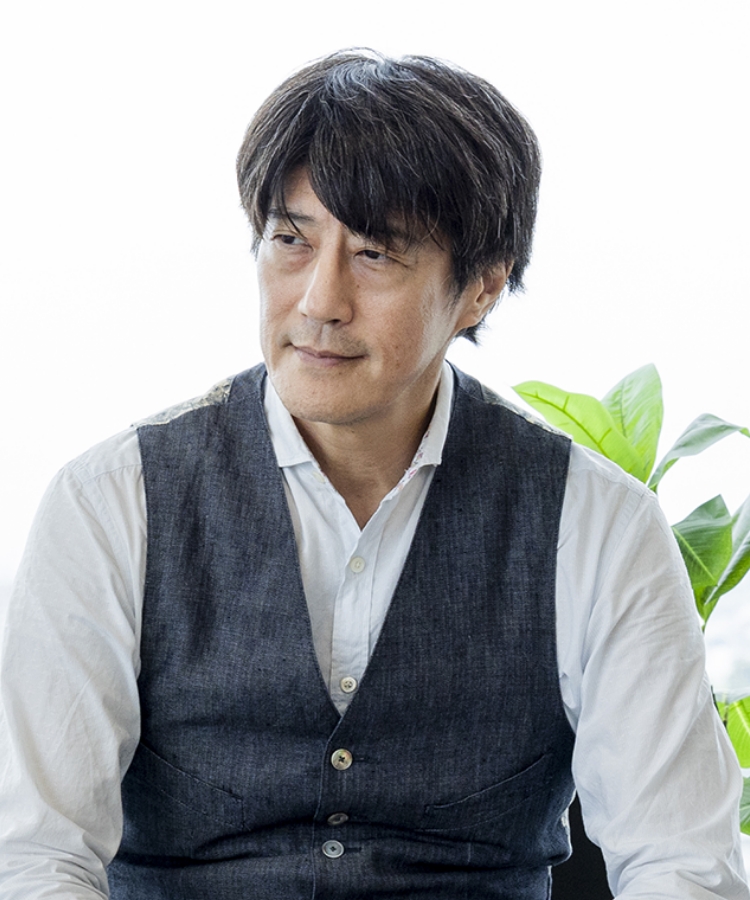
#Asia University research
SAITO Akihiro Professor
Faculty of Urban Innovation Department of Urban Innovation
2023.10.01
In the series "If it's not interesting, it's not academia!", we introduce the research content and anecdotes of faculty members at Asia University. The second feature is Professor SAITO Akihiro Faculty of Urban Innovation, Department of Urban Innovation.
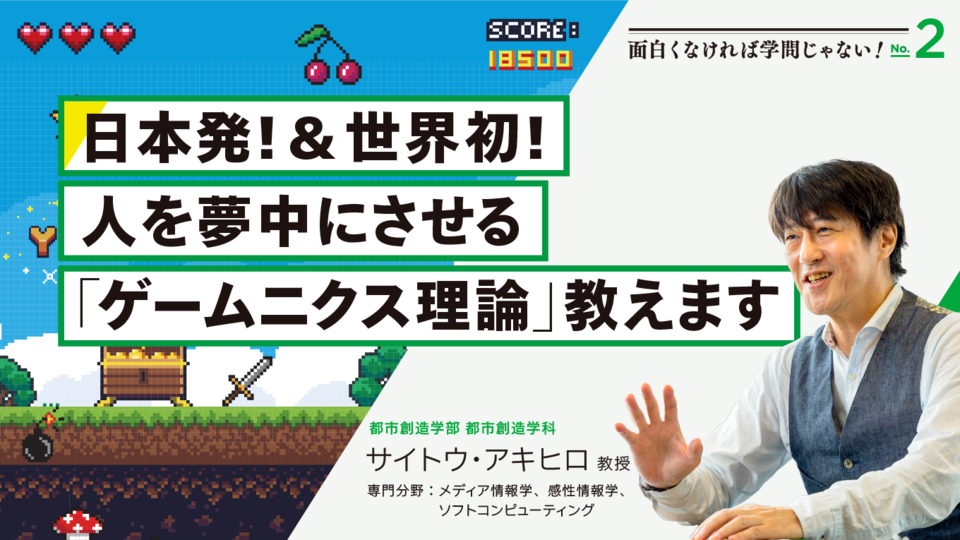
The birth of the Famicom
"Gamenics Theory"
The night before the birth
"Gamenics Theory"
The night before the birth
I started working as an animator before entering art school, and after graduating from university, I was involved in the production of numerous commercials, and the works I created had already been aired on TV and received high praise.
At that time, I met Satoshi Iwata, who was making games for Nintendo, and he asked me to help him make games. Mr. Iwata was an extremely talented programmer, but he was incapable of creating visuals, which is essential for games. So they asked me, who had a proven track record in animation and video work, to collaborate and say, ``Would you like to create a game with me?''
The games I created with Mr. Iwata for the Famicom ended up being released under the Nintendo brand. Since then, I have gained experience as a game creator while working on commercial production. During that time, I had close contact with game creators who are now legendary, including not only Mr. Iwata, who later became the president of Nintendo, but also Shigeru Miyamoto, the creator of Mario, The Legend of Zelda, and Donkey Kong. I worked. That time was an irreplaceable experience for me, and eventually working on games became my full-time job.
At first, games were considered nothing more than children's toys, but in the 21st century, they have come to be recognized by society as an important form of entertainment "culture." Thanks to this, even though I was a game creator, I was invited to teach at a university in Kyoto where Nintendo is located. Until then, there was no particular academic system for games, so when I taught it to students, I compiled my experience and know-how in making games into a system of my own. That is "gamenics theory".
Born from the development site
Captivate people
Methodological Accumulation
Captivate people
Methodological Accumulation
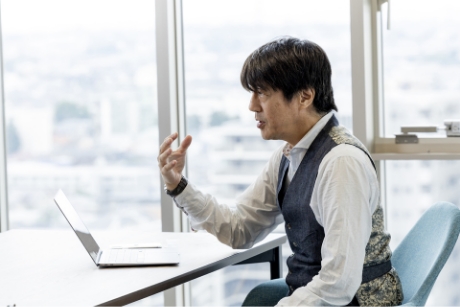
"Gamenics theory" is different from existing academic theories. It is an accumulation of specific methodologies for "engrossing people" that have been accumulated in the field of game development, a crystallization of the wisdom and sweat of the pioneering game craftsmen. In constructing Gamenics theory, I looked back on my experience of trial and error with Iwata and his team, and categorized it into five major elements, each of which was associated with specific know-how and work, and organized into a theoretical system. It is no exaggeration to say that it contains everything "necessary to enthral people."
The "five elements" of Gamenics theory are "① an intuitive and comfortable interface," "② usability without the need for a manual," "③ an addictive presentation," "④ gradual learning effect," and "⑤ a link between the real and the virtual." Of these, the first two, "① an intuitive and comfortable interface" and "② usability without the need for a manual," are particularly important elements.
"① Intuitive and comfortable interface" refers to the pursuit of optimization of interfaces such as controllers that anyone can operate intuitively and instinctively by properly managing the layout of buttons on the screen and their shapes. The controller is the only point of contact between the game and the user. A major factor in the success of the Famicom was the "D-pad + AB buttons," and the history of games can be said to be the history of the pursuit of interface optimization. The "D-pad" is still used in games today. It was a groundbreaking invention by Nintendo.
"② Usability without the need for a manual" refers to methods of providing users with the knowledge they want to know, when they want to know it, without being intrusive, by guiding them with design, sound, and animation, or by incorporating a manual into the game, so that they can understand complex rules and controls while enjoying the game, without having to read a thick manual.
Furthermore, "③ Addictive production" covers the game's tempo and scene rhythm, the balance between stress and pleasure, the joy of discovery, and mechanisms to keep players playing the game; "④ Gradual learning effects" covers know-how for enjoying games for long periods of time, such as setting personal goals and learning effects that aren't imposed; and "⑤ Linking the real and virtual" is about creating fun and excitement that can be obtained by linking with networks, which have become mainstream...I teach these details to my students every day, and I'm sure that as they play games a lot, there are many things that they will nod at and say, "I see!" even if they don't normally notice.
The "five elements" of Gamenics theory are "① an intuitive and comfortable interface," "② usability without the need for a manual," "③ an addictive presentation," "④ gradual learning effect," and "⑤ a link between the real and the virtual." Of these, the first two, "① an intuitive and comfortable interface" and "② usability without the need for a manual," are particularly important elements.
"① Intuitive and comfortable interface" refers to the pursuit of optimization of interfaces such as controllers that anyone can operate intuitively and instinctively by properly managing the layout of buttons on the screen and their shapes. The controller is the only point of contact between the game and the user. A major factor in the success of the Famicom was the "D-pad + AB buttons," and the history of games can be said to be the history of the pursuit of interface optimization. The "D-pad" is still used in games today. It was a groundbreaking invention by Nintendo.
"② Usability without the need for a manual" refers to methods of providing users with the knowledge they want to know, when they want to know it, without being intrusive, by guiding them with design, sound, and animation, or by incorporating a manual into the game, so that they can understand complex rules and controls while enjoying the game, without having to read a thick manual.
Furthermore, "③ Addictive production" covers the game's tempo and scene rhythm, the balance between stress and pleasure, the joy of discovery, and mechanisms to keep players playing the game; "④ Gradual learning effects" covers know-how for enjoying games for long periods of time, such as setting personal goals and learning effects that aren't imposed; and "⑤ Linking the real and virtual" is about creating fun and excitement that can be obtained by linking with networks, which have become mainstream...I teach these details to my students every day, and I'm sure that as they play games a lot, there are many things that they will nod at and say, "I see!" even if they don't normally notice.
For all kinds of manufacturing
Applicable
Gamenics Theory
Applicable
Gamenics Theory
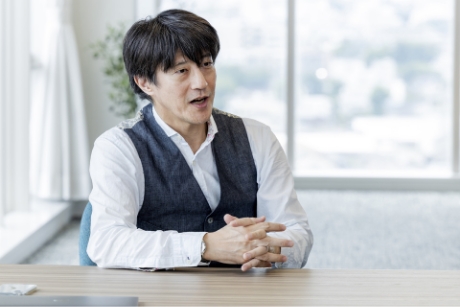
In the 40 years since the birth of the Famicom, gaming entertainment has continued to change significantly with the times. The reason I am still able to teach young students even though I am 60 years old is because I am still active and involved in games. Having said that, I'm not a "game" fanatic. I just love creating things, and I just can't stop. I was once invited to become Officer at a game company with good pay, but I was not interested and turned it down. I'm not a manager or manager, I'm just a manufacturing person. However, I enjoy teaching young students, and I find the job of ``developing people'' very rewarding.
Gamenics theory can be fully applied to the world of ``human resources development'' (education). Currently, the digitalization of education is progressing, but from my perspective, there is still a long way to go... It's important to not just make studying into a game, but also to make learning fun within the mechanics of the game, and I've created games that make learning fun.
Furthermore, I provide advice to various companies on product development that applies gamenics theory, in order to have them apply and put gamenics theory into practice in Japan's future manufacturing. A recent example of commercialization is a ``rehabilitation robot'' jointly developed with Toyota Motor Corporation that allows rehabilitation to be carried out in a game-like manner. By using this robot, patients can become immersed in rehabilitation as if they were playing a game, and we have achieved a functional recovery rate that is approximately 1.7 times higher than before.
There are still many problems around us that can be solved using gamenics theory. Examples include TV remote controls with many buttons, ordering tablets at family restaurants and other restaurants, and unmanned checkout machines at supermarkets. Many people find these difficult to use. Gamenics theory, which emphasizes comfortable interfaces, can be of great help in resolving this difficulty of use. In some cities, guidance using touch sensors is increasing. By applying gamenics theory to these things, we can make our lives richer and more enjoyable.
Gamenics theory can be fully applied to the world of ``human resources development'' (education). Currently, the digitalization of education is progressing, but from my perspective, there is still a long way to go... It's important to not just make studying into a game, but also to make learning fun within the mechanics of the game, and I've created games that make learning fun.
Furthermore, I provide advice to various companies on product development that applies gamenics theory, in order to have them apply and put gamenics theory into practice in Japan's future manufacturing. A recent example of commercialization is a ``rehabilitation robot'' jointly developed with Toyota Motor Corporation that allows rehabilitation to be carried out in a game-like manner. By using this robot, patients can become immersed in rehabilitation as if they were playing a game, and we have achieved a functional recovery rate that is approximately 1.7 times higher than before.
There are still many problems around us that can be solved using gamenics theory. Examples include TV remote controls with many buttons, ordering tablets at family restaurants and other restaurants, and unmanned checkout machines at supermarkets. Many people find these difficult to use. Gamenics theory, which emphasizes comfortable interfaces, can be of great help in resolving this difficulty of use. In some cities, guidance using touch sensors is increasing. By applying gamenics theory to these things, we can make our lives richer and more enjoyable.
With the Kyoto spirit of "omotenashi"
Japanese manufacturing
Be healthy!
Japanese manufacturing
Be healthy!
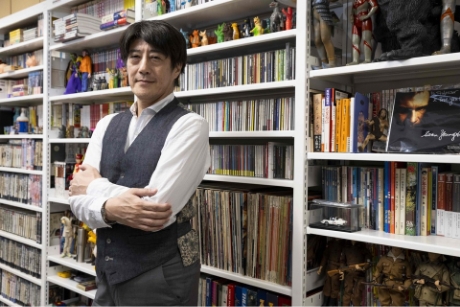
Games are entertainment that originated in Japan. In fact, a major American toy manufacturer had released a home video game console before the release of the Famicom, but they misjudged the market's maturity and made a huge mistake. It was Nintendo who dared to sow the seeds of games once again in this barren market that had once disappeared. It is truly Japan's soft power that allowed the humble sapling of the Famicom to grow into a major industry and blossom all over the world. Moreover, the game industry is still expanding, and the global market size far exceeds that of Hollywood and other movie industries. The fact that Japan has created and led this major entertainment industry is a miracle in the history of Japanese culture.
So why were Japanese companies able to succeed in establishing a game industry where the United States failed? This is the spirit of "hospitality" in Kyoto, where the traditional culture of Japan is alive and well. Nowadays, many inbound tourists visit Kyoto because they are attracted to Japanese things. The people of Kyoto provide subtle hospitality that entertains and makes visitors happy. I realized this deeply while working with Nintendo, which is headquartered in Kyoto. Gamenics theory is a system based on "Kyoto hospitality" in the interactive media of games, and it can be said to be a unique Japanese technique that cannot be easily imitated by people overseas. It is.
In recent years, manufacturing in Japan seems to be a little lackluster, but I believe that the day will come when it will once again take the world by storm through the application of "gamenics theory." The young people of the generation I am currently teaching at university will be the key players in this era. I still have to work hard toward the goal of creating Japan's "manufacturing" and "developing people" tomorrow.
So why were Japanese companies able to succeed in establishing a game industry where the United States failed? This is the spirit of "hospitality" in Kyoto, where the traditional culture of Japan is alive and well. Nowadays, many inbound tourists visit Kyoto because they are attracted to Japanese things. The people of Kyoto provide subtle hospitality that entertains and makes visitors happy. I realized this deeply while working with Nintendo, which is headquartered in Kyoto. Gamenics theory is a system based on "Kyoto hospitality" in the interactive media of games, and it can be said to be a unique Japanese technique that cannot be easily imitated by people overseas. It is.
In recent years, manufacturing in Japan seems to be a little lackluster, but I believe that the day will come when it will once again take the world by storm through the application of "gamenics theory." The young people of the generation I am currently teaching at university will be the key players in this era. I still have to work hard toward the goal of creating Japan's "manufacturing" and "developing people" tomorrow.
Related Links
- Faculty of Urban Innovation TOP
- Introduction to Faculty of Urban Innovation Department of Urban Innovation
- Four years of study Faculty of Urban Innovation Department of Urban Innovation
- Faculty of Urban Innovation Department of Urban Innovation Introduction
- Faculty Faculty of Urban Innovation Department of Urban Innovation
- Faculty of Urban Innovation Department of Urban Innovation Abroad + Overseas Work Experience
- Faculty introduction of Faculty of Urban Innovation Department of Urban Innovation